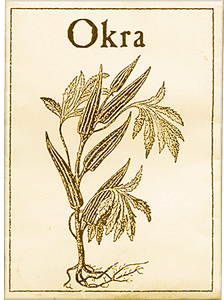OKRA
Vitals
• Hibiscus esculentus , belonging to the cotton family, Malvaceae.
• Origin: Ethiopia, Eritrea, and Sudan, evidenced by populations of wild plants growing in this region.
• Earliest cultivation: Spanish Moors visiting Egypt described okra cultivation there in detail in 1216.
• Other areas with early cultivation: North Africa, eastern Mediterranean, Arabia, and India.
• Climate: Tropical.
• Major producing countries: India, Nigeria, Pakistan.
Short history
Okra’s such a wholesome food
It straightens out your attitude.
The writer Roy Blount Jr. was so inspired by okra that he wrote an entire ode singing its praises. This little pod, related to cotton, has thickened stews for centuries in the Middle East and India. It arrived in North America and Brazil via the slave trade, and has since been a staple in soul food of the American South. Indians in Louisiana discovered its thickening properties and shared their find with French colonists. The result is the famous Creole gumbo. The name is probably an adaptation of ochingombo, the word used for the vegetable by Angolan slaves.
Okra facts and loreIn some countries, okra seeds are roasted, ground up, and used to make a coffeelike brew.
Having a hard time getting your ketchup out of the bottle? You’ve got okra to thank. The pod’s gooey insides are used to give some ketchups their holding power.
Okra is one of only a very few common vegetables with an African origin. There is little known about okra’s early days, as there was little contact between northeastern Africa and Western parts of the world during that time.
Okra pods have stiff hairs on the outside that can irritate skin. Use gloves when you’re harvesting okra!
Saving the seedOkra seeds themselves are large and easy to see, but the dried okra pods can present problems. Wear gloves when harvesting and opening the pods. Okra seeds are viable for about five years.
• Grow only one variety of okra if you want to save seeds; otherwise the plants may cross-pollinate.
• Decide which of your okra plants you think has the best traits: earliest blooms, most pods, best adapted to your conditions, and the like.
• Wearing gloves, pick a few mature pods from the best plant. You can pick them green, as long as they are mature, and leave them to dry until they split open.
• Again wearing gloves, break the pods open over a bowl, letting the seeds fall in. To make this process more fun, you can instead put the dried pods in a pillowcase, put the pillowcase on a hard surface, and jog in place on it. Then place the crushed pods in a bowl.
• Winnow (blow away the chaff) with a hair dryer or fan.
• Store them in a cool, dry place away from light until you are ready to plant them.
Saving and planting seeds is easy. Make sure that the plants you are saving seed from are what’s called an “open-pollinating” rather than a hybrid variety. For a list of companies that sell seeds for open-pollinating plants, see our article Why Save Seeds?
